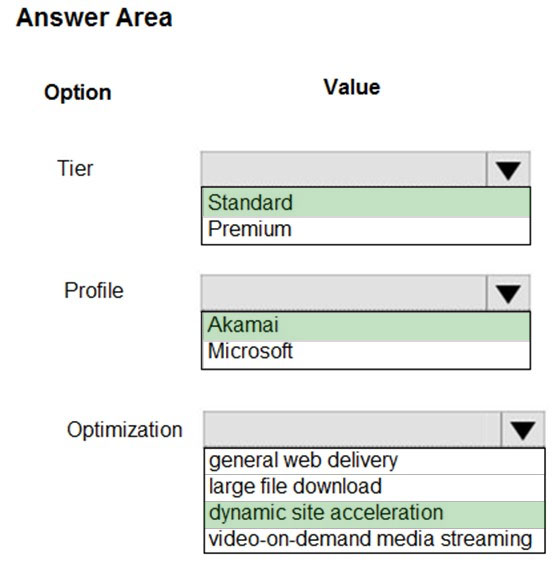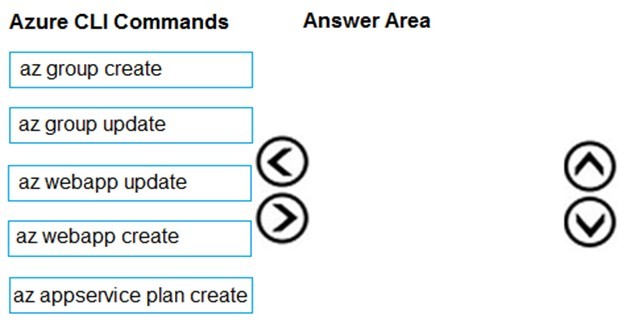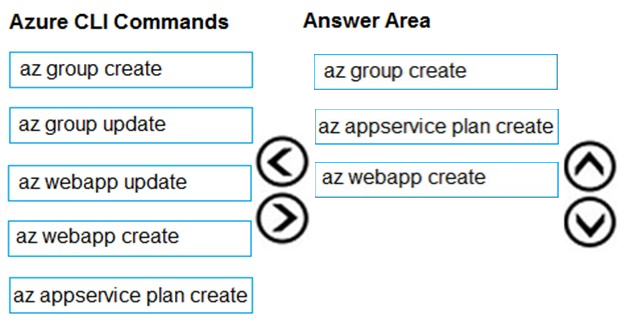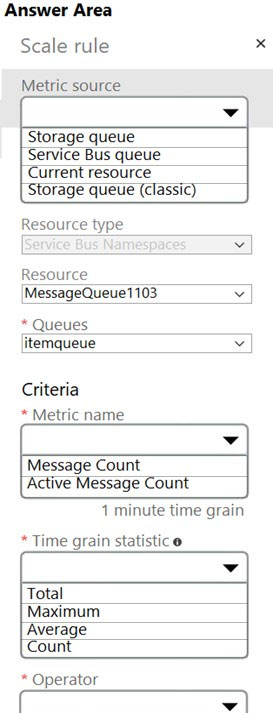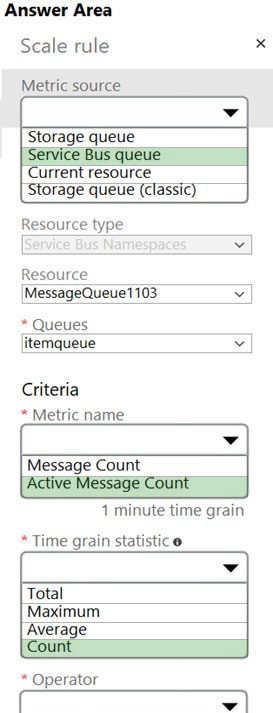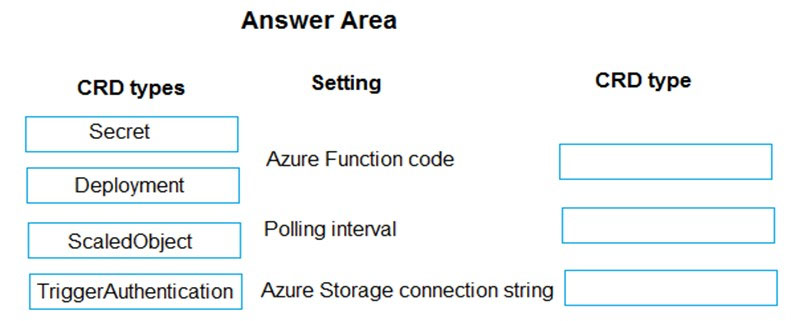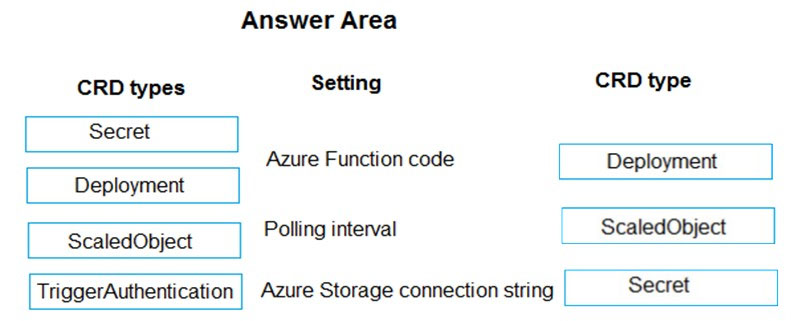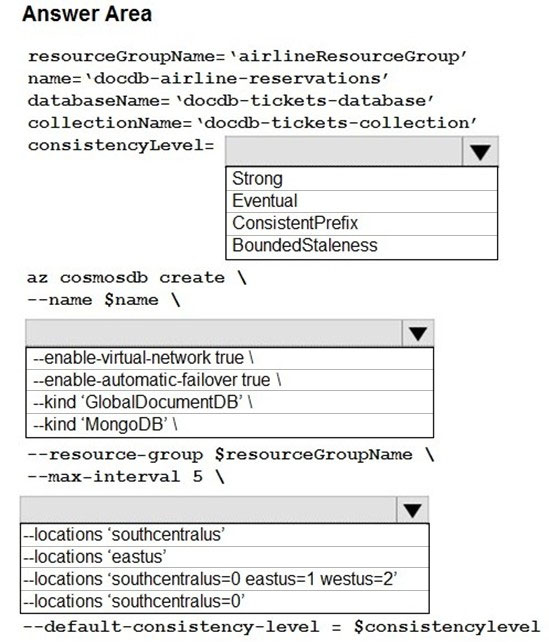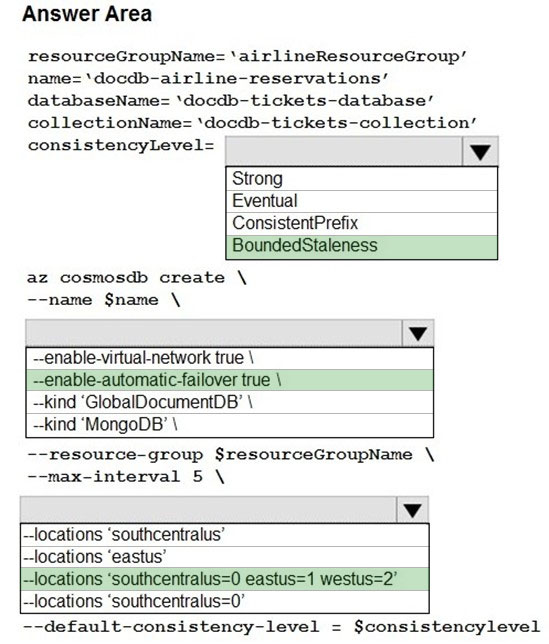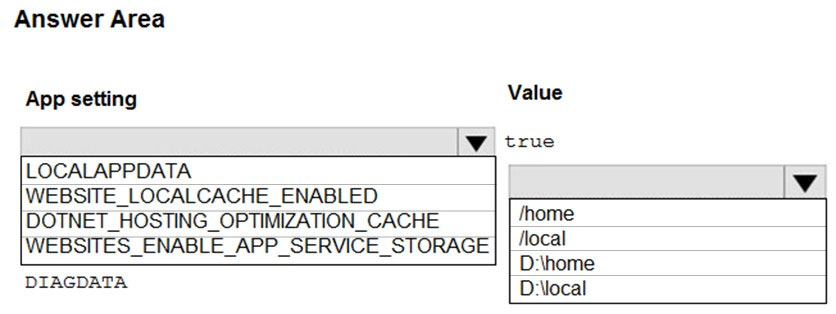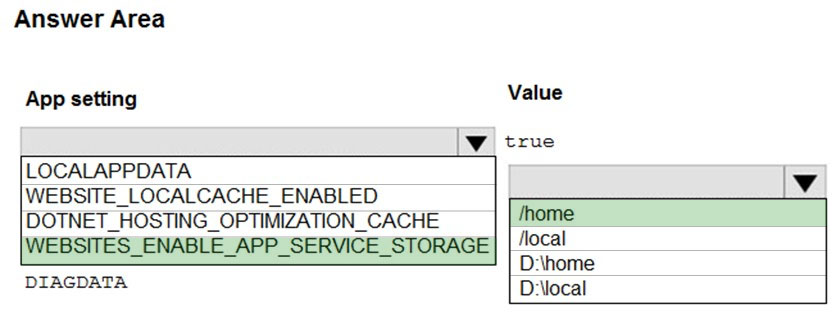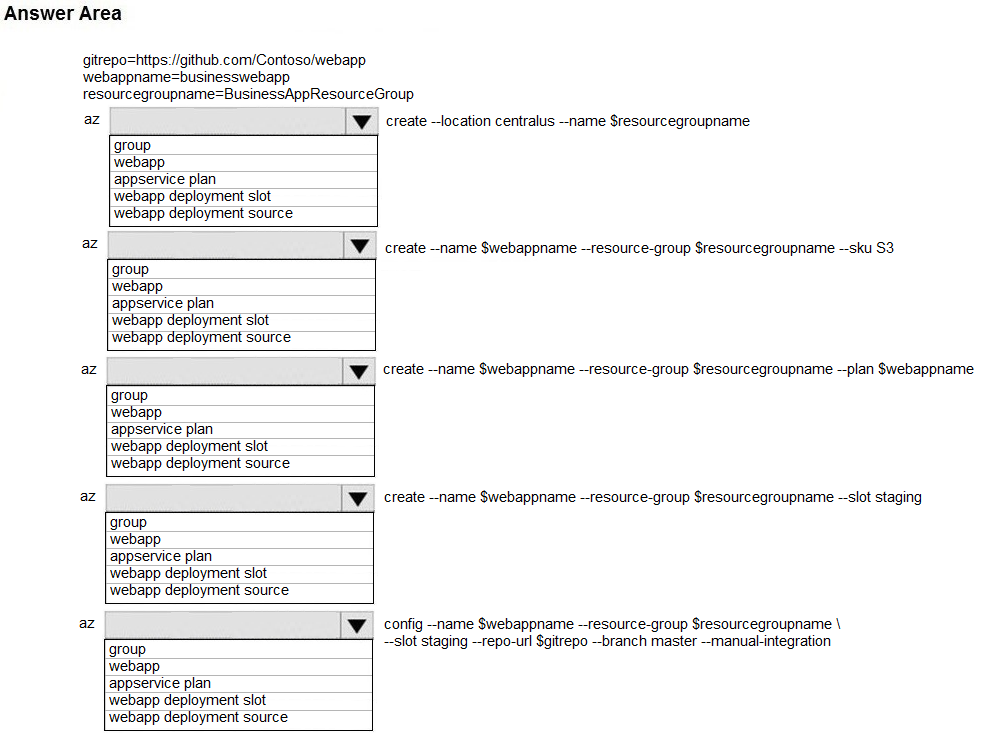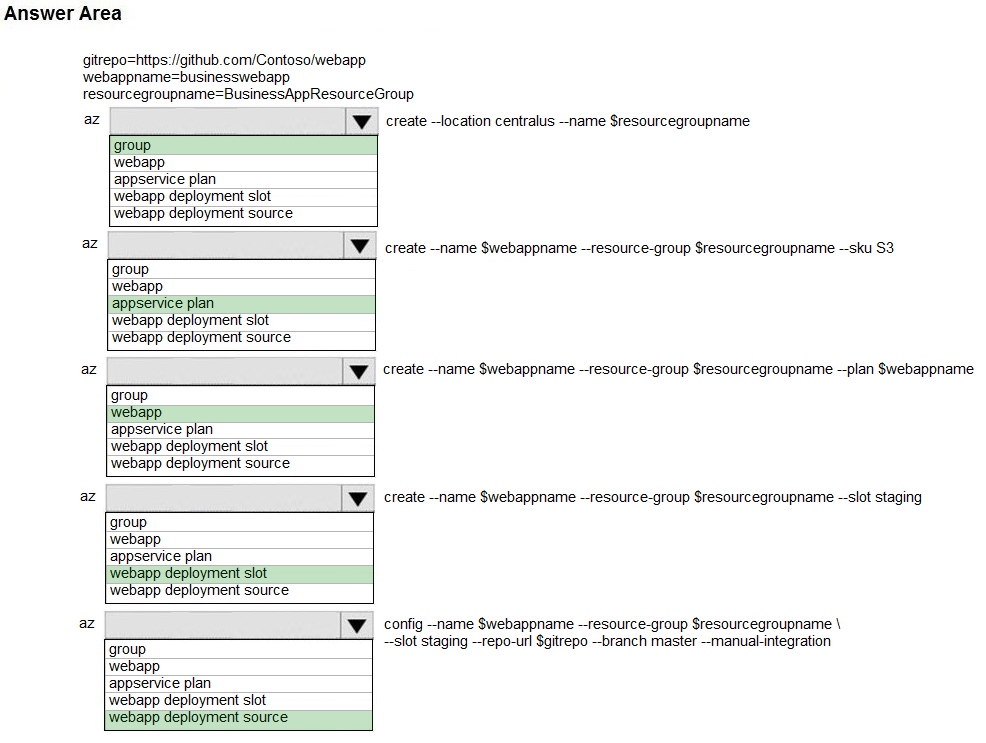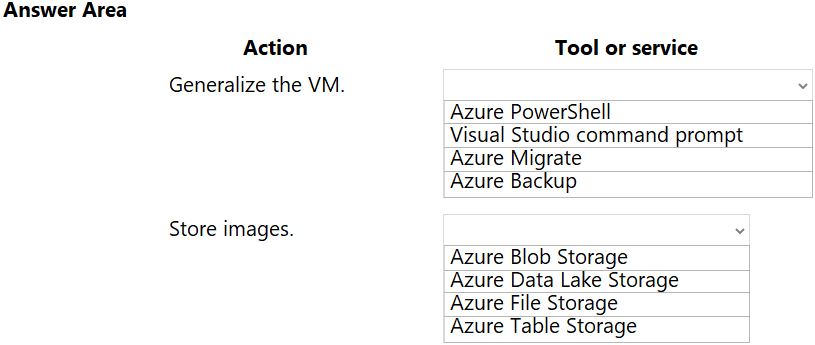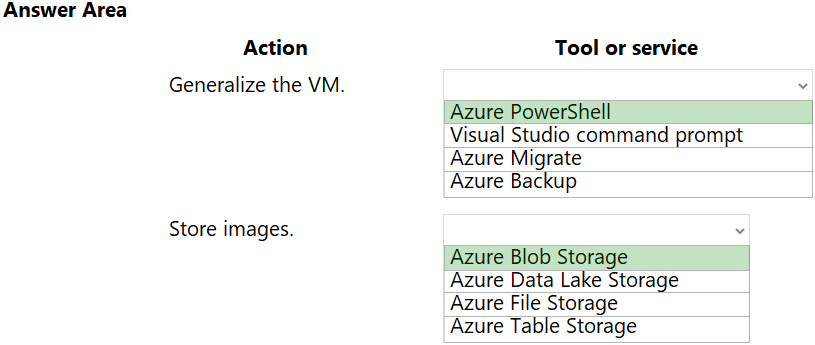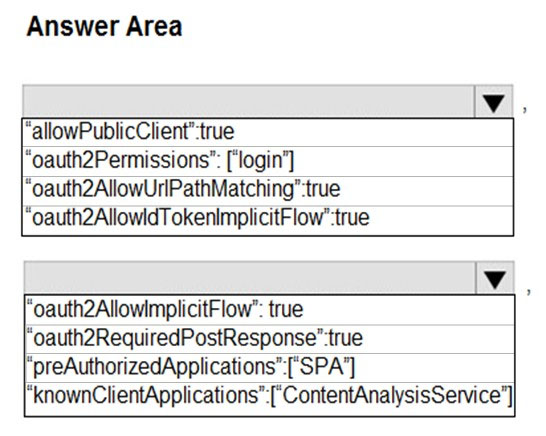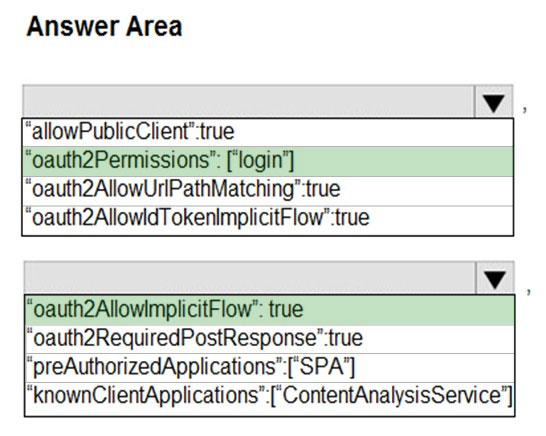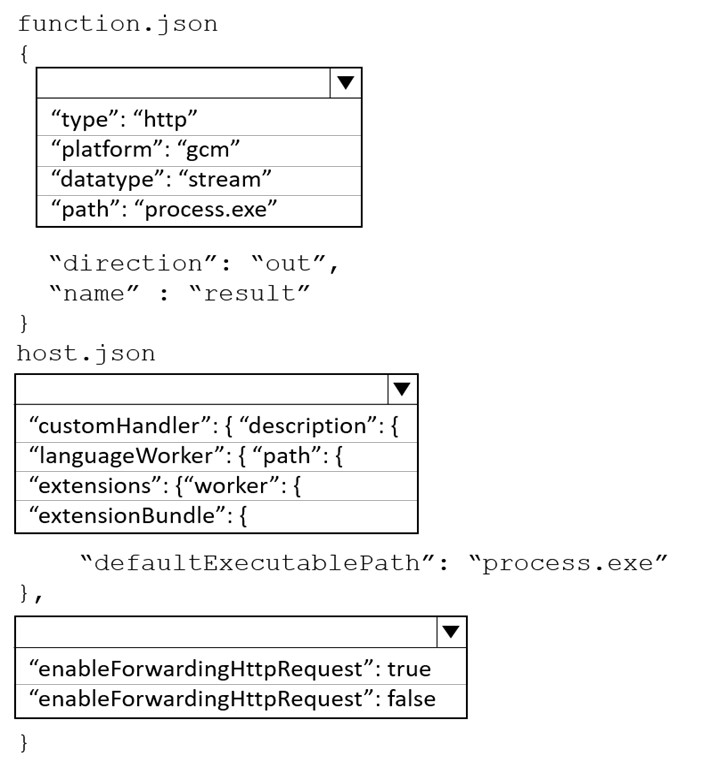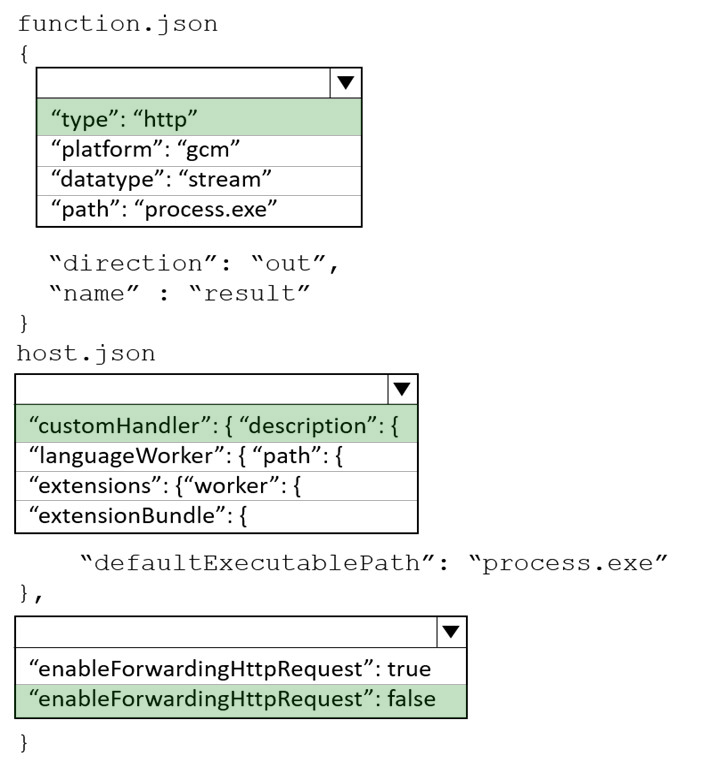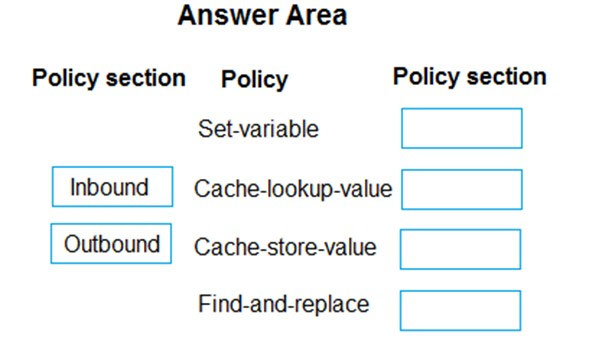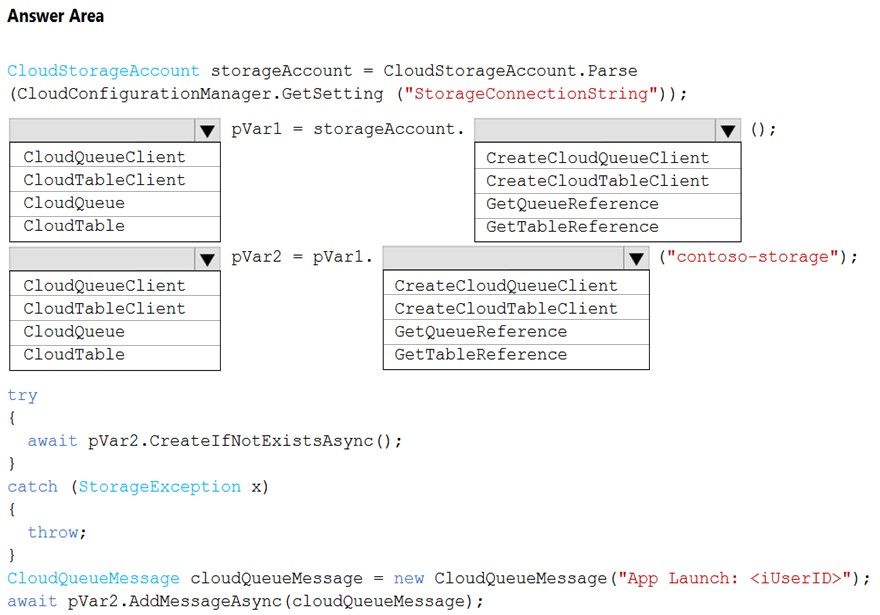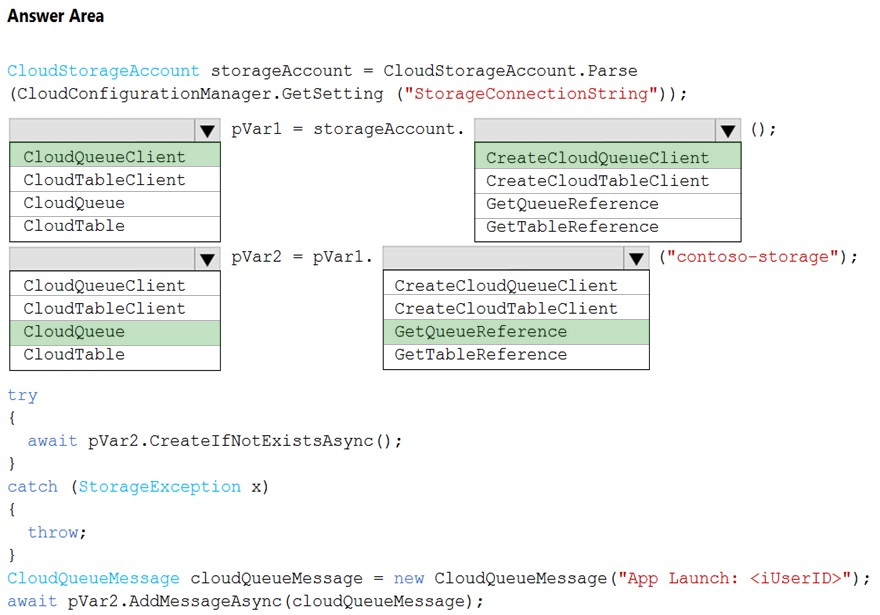AZ-204 Mock Test Free – 50 Realistic Questions to Prepare with Confidence.
Getting ready for your AZ-204 certification exam? Start your preparation the smart way with our AZ-204 Mock Test Free – a carefully crafted set of 50 realistic, exam-style questions to help you practice effectively and boost your confidence.
Using a mock test free for AZ-204 exam is one of the best ways to:
- Familiarize yourself with the actual exam format and question style
- Identify areas where you need more review
- Strengthen your time management and test-taking strategy
Below, you will find 50 free questions from our AZ-204 Mock Test Free resource. These questions are structured to reflect the real exam’s difficulty and content areas, helping you assess your readiness accurately.
Note: This question is part of a series of questions that present the same scenario. Each question in the series contains a unique solution. Determine whether the solution meets the stated goals. You are developing and deploying several ASP.NET web applications to Azure App Service. You plan to save session state information and HTML output. You must use a storage mechanism with the following requirements: ✑ Share session state across all ASP.NET web applications. ✑ Support controlled, concurrent access to the same session state data for multiple readers and a single writer. ✑ Save full HTTP responses for concurrent requests. You need to store the information. Proposed Solution: Deploy and configure an Azure Database for PostgreSQL. Update the web applications. Does the solution meet the goal?
A. Yes
B. No
You are developing an Azure App Service web app. The web app must securely store session information in Azure Redis Cache. You need to connect the web app to Azure Redis Cache. Which three Azure Redis Cache properties should you use? Each correct answer presents part of the solution. NOTE: Each correct selection is worth one point.
A. Access key
B. SSL port
C. Subscription name
D. Location
E. Host name
F. Subscription id
You deploy an Azure App Service web app. You create an app registration for the app in Azure Active Directory (Azure AD) and Twitter. The app must authenticate users and must use SSL for all communications. The app must use Twitter as the identity provider. You need to validate the Azure AD request in the app code. What should you validate?
A. ID token header
B. ID token signature
C. HTTP response code
D. Tenant ID
HOTSPOT - Case study - This is a case study. Case studies are not timed separately. You can use as much exam time as you would like to complete each case. However, there may be additional case studies and sections on this exam. You must manage your time to ensure that you are able to complete all questions included on this exam in the time provided. To answer the questions included in a case study, you will need to reference information that is provided in the case study. Case studies might contain exhibits and other resources that provide more information about the scenario that is described in the case study. Each question is independent of the other questions in this case study. At the end of this case study, a review screen will appear. This screen allows you to review your answers and to make changes before you move to the next section of the exam. After you begin a new section, you cannot return to this section. To start the case study - To display the first question in this case study, click the Next button. Use the buttons in the left pane to explore the content of the case study before you answer the questions. Clicking these buttons displays information such as business requirements, existing environment, and problem statements. When you are ready to answer a question, click the Question button to return to the question. Background - Munson’s Pickles and Preserves Farm is an agricultural cooperative corporation based in Washington, US, with farms located across the United States. The company supports agricultural production resources by distributing seeds fertilizers, chemicals, fuel, and farm machinery to the farms. Current Environment - The company is migrating all applications from an on-premises datacenter to Microsoft Azure. Applications support distributors, farmers, and internal company staff. Corporate website - • The company hosts a public website located at http://www.munsonspicklesandpreservesfarm.com. The site supports farmers and distributors who request agricultural production resources. Farms - • The company created a new customer tenant in the Microsoft Entra admin center to support authentication and authorization for applications. Distributors - • Distributors integrate their applications with data that is accessible by using APIs hosted at http://www.munsonspicklesandpreservesfarm.com/api to receive and update resource data. Requirements - The application components must meet the following requirements: Corporate website - • The site must be migrated to Azure App Service. • Costs must be minimized when hosting in Azure. • Applications must automatically scale independent of the compute resources. • All code changes must be validated by internal staff before release to production. • File transfer speeds must improve, and webpage-load performance must increase. • All site settings must be centrally stored, secured without using secrets, and encrypted at rest and in transit. • A queue-based load leveling pattern must be implemented by using Azure Service Bus queues to support high volumes of website agricultural production resource requests. Farms - • Farmers must authenticate to applications by using Microsoft Entra ID. Distributors - • The company must track a custom telemetry value with each API call and monitor performance of all APIs. • API telemetry values must be charted to evaluate variations and trends for resource data. Internal staff - • App and API updates must be validated before release to production. • Staff must be able to select a link to direct them back to the production app when validating an app or API update. • Staff profile photos and email must be displayed on the website once they authenticate to applications by using their Microsoft Entra ID. Security - • All web communications must be secured by using TLS/HTTPS. • Web content must be restricted by country/region to support corporate compliance standards. • The principle of least privilege must be applied when providing any user rights or process access rights. • Managed identities for Azure resources must be used to authenticate services that support Microsoft Entra ID authentication. Issues - Corporate website - • Farmers report HTTP 503 errors at the same time as internal staff report that CPU and memory usage are high. • Distributors report HTTP 502 errors at the same time as internal staff report that average response times and networking traffic are high. • Internal staff report webpage load sizes are large and take a long time to load. • Developers receive authentication errors to Service Bus when they debug locally. Distributors - • Many API telemetry values are sent in a short period of time. Telemetry traffic, data costs, and storage costs must be reduced while preserving a statistically correct analysis of the data points sent by the APIs. You need to provide internal staff access to the production site after a validation. How should you complete the code segment? To answer, select the appropriate options in the answer area. NOTE: Each correct selection is worth one point.
HOTSPOT - You need to configure Azure CDN for the Shipping web site. Which configuration options should you use? To answer, select the appropriate options in the answer area. NOTE: Each correct selection is worth one point. Hot Area:
This question requires that you evaluate the underlined text to determine if it is correct. Your Azure Active Directory Azure (Azure AD) tenant has an Azure subscription linked to it. Your developer has created a mobile application that obtains Azure AD access tokens using the OAuth 2 implicit grant type. The mobile application must be registered in Azure AD. You require a redirect URI from the developer for registration purposes. Instructions: Review the underlined text. If it makes the statement correct, select `No change is needed.` If the statement is incorrect, select the answer choice that makes the statement correct.
A. No change required.
B. a secret
C. a login hint
D. a client ID
A company is developing a solution that allows smart refrigerators to send temperature information to a central location. The solution must receive and store messages until they can be processed. You create an Azure Service Bus instance by providing a name, pricing tier, subscription, resource group, and location. You need to complete the configuration. Which Azure CLI or PowerShell command should you run?
A.

B.

C.

D.

You are building a web application that performs image analysis on user photos and returns metadata containing objects identified. The image analysis is very costly in terms of time and compute resources. You are planning to use Azure Redis Cache so duplicate uploads do not need to be reprocessed. In case of an Azure data center outage, metadata loss must be kept to a minimum. You need to configure the Azure Redis cache instance. Which two actions should you perform? Each correct answer presents part of the solution. NOTE: Each correct selection is worth one point.
A. Configure Azure Redis with AOF persistence.
B. Configure Azure Redis with RDB persistence.
C. Configure second storage account for persistence.
D. Set backup frequency to the minimum value.
You are developing several Azure API Management (APIM) hosted APIs. You must make several minor and non-breaking changes to one of the APIs. The API changes include the following requirements: • Must not disrupt callers of the API. • Enable roll back if you find issues. • Documented to enable developers to understand what is new. • Tested before publishing. You need to update the API. What should you do?
A. Configure and apply header-based versioning.
B. Create and publish a product.
C. Configure and apply a custom policy.
D. Add a new revision to the API.
E. Configure and apply query string-based versioning.
DRAG DROP - You have an Azure Cosmos DB for NoSQL account. You plan to develop two apps named App1 and App2 that will use the change feed functionality to track changes to containers. App1 will use the pull model and App2 will use the push model. You need to choose the method to track the most recently processed change in App1 and App2. Which component should you use? To answer, drag the appropriate components to the correct apps. Each component may be used once, more than once, or not at all. You may need to drag the split bar between panes or scroll to view content. NOTE: Each correct selection is worth one point.
DRAG DROP - You develop an Azure solution that uses Cosmos DB. The current Cosmos DB container must be replicated and must use a partition key that is optimized for queries. You need to implement a change feed processor solution. Which change feed processor components should you use? To answer, drag the appropriate components to the correct requirements. Each component may be used once, more than once, or not at all. You may need to drag the split bar between panes or scroll to view the content. NOTE: Each correct selection is worth one point. Select and Place:
After you answer a question in this section, you will NOT be able to return to it. As a result, these questions will not appear in the review screen. You develop a software as a service (SaaS) offering to manage photographs. Users upload photos to a web service which then stores the photos in Azure Storage Blob storage. The storage account type is General-purpose V2. When photos are uploaded, they must be processed to produce and save a mobile-friendly version of the image. The process to produce a mobile-friendly version of the image must start in less than one minute. You need to design the process that starts the photo processing. Solution: Convert the Azure Storage account to a BlockBlobStorage storage account. Does the solution meet the goal?
A. Yes
B. No
You develop a website. You plan to host the website in Azure. You expect the website to experience high traffic volumes after it is published. You must ensure that the website remains available and responsive while minimizing cost. You need to deploy the website. What should you do?
A. Deploy the website to a virtual machine. Configure the virtual machine to automatically scale when the CPU load is high.
B. Deploy the website to an App Service that uses the Shared service tier. Configure the App Service plan to automatically scale when the CPU load is high.
C. Deploy the website to a virtual machine. Configure a Scale Set to increase the virtual machine instance count when the CPU load is high.
D. Deploy the website to an App Service that uses the Standard service tier. Configure the App Service plan to automatically scale when the CPU load is high.
DRAG DROP - You develop and deploy a Java application to Azure. The application has been instrumented by using the Application Insights SDK. The telemetry data must be enriched and processed before it is sent to the Application Insights service. You need to modify the telemetry data. Which Application Insights SDK features should you use? To answer, drag the appropriate features to the correct requirements. Each feature may be used once, more than once, or not at all. You may need to drag the split bar between panes or scroll to view content. NOTE: Each correct selection is worth one point.
After you answer a question in this section, you will NOT be able to return to it. As a result, these questions will not appear in the review screen. You are developing an Azure solution to collect point-of-sale (POS) device data from 2,000 stores located throughout the world. A single device can produce 2 megabytes (MB) of data every 24 hours. Each store location has one to five devices that send data. You must store the device data in Azure Blob storage. Device data must be correlated based on a device identifier. Additional stores are expected to open in the future. You need to implement a solution to receive the device data. Solution: Provision an Azure Service Bus. Configure a topic to receive the device data by using a correlation filter. Does the solution meet the goal?
A. Yes
B. No
DRAG DROP - You are developing a Docker/Go using Azure App Service Web App for Containers. You plan to run the container in an App Service on Linux. You identify a Docker container image to use. None of your current resource groups reside in a location that supports Linux. You must minimize the number of resource groups required. You need to create the application and perform an initial deployment. Which three Azure CLI commands should you use to develop the solution? To answer, move the appropriate commands from the list of commands to the answer area and arrange them in the correct order. Select and Place:
HOTSPOT - You are developing a back-end Azure App Service that scales based on the number of messages contained in a Service Bus queue. A rule already exists to scale up the App Service when the average queue length of unprocessed and valid queue messages is greater than 1000. You need to add a new rule that will continuously scale down the App Service as long as the scale up condition is not met. How should you configure the Scale rule? To answer, select the appropriate options in the answer area. NOTE: Each correct selection is worth one point. Hot Area:
You need to reduce read latency for the retail store solution. What are two possible ways to achieve the goal? Each correct answer presents a complete solution. NOTE: Each correct selection is worth one point.
A. Create a new composite index for the store location data queries in Azure Cosmos DB. Modify the queries to support parameterized SQL and update the Azure Function app to call the new queries.
B. Provision an Azure Cosmos DB dedicated gateway. Update the Azure Function app connection string to use the new dedicated gateway endpoint.
C. Configure Azure Cosmos DB consistency to session consistency. Cache session tokens in a new Azure Redis cache instance after every write. Update reads to use the session token stored in Azure Redis.
D. Provision an Azure Cosmos DB dedicated gateway. Update blob storage to use the new dedicated gateway endpoint.
E. Configure Azure Cosmos DB consistency to strong consistency. Increase the RUs for the container supporting store location data.
You are developing an Azure Durable Function to manage an online ordering process. The process must call an external API to gather product discount information. You need to implement the Azure Durable Function. Which Azure Durable Function types should you use? Each correct answer presents part of the solution. NOTE: Each correct selection is worth one point.
A. Orchestrator
B. Entity
C. Client
D. Activity
DRAG DROP - You are a developer for a software as a service (SaaS) company that uses an Azure Function to process orders. The Azure Function currently runs on an Azure Function app that is triggered by an Azure Storage queue. You are preparing to migrate the Azure Function to Kubernetes using Kubernetes-based Event Driven Autoscaling (KEDA). You need to configure Kubernetes Custom Resource Definitions (CRD) for the Azure Function. Which CRDs should you configure? To answer, drag the appropriate CRD types to the correct locations. Each CRD type may be used once, more than once, or not at all. You may need to drag the split bar between panes or scroll to view content. NOTE: Each correct selection is worth one point. Select and Place:
You are a developer at your company. You need to edit the workflows for an existing Logic App. What should you use?
A. the Enterprise Integration Pack (EIP)
B. the Logic App Code View
C. the API Connections
D. the Logic Apps Designer
HOTSPOT - You are developing a ticket reservation system for an airline. The storage solution for the application must meet the following requirements: ✑ Ensure at least 99.99% availability and provide low latency. ✑ Accept reservations even when localized network outages or other unforeseen failures occur. ✑ Process reservations in the exact sequence as reservations are submitted to minimize overbooking or selling the same seat to multiple travelers. ✑ Allow simultaneous and out-of-order reservations with a maximum five-second tolerance window. You provision a resource group named airlineResourceGroup in the Azure South-Central US region. You need to provision a SQL API Cosmos DB account to support the app. How should you complete the Azure CLI commands? To answer, select the appropriate options in the answer area. NOTE: Each correct selection is worth one point. Hot Area:
HOTSPOT - You provisioned an Azure Cosmos DB for NoSQL account named account1 with the default consistency level. You plan to configure the consistency level on a per request basis. The level needs to be set for consistent prefix for read and write operations to account1. You need to identify the resulting consistency level for read and write operations. Which levels should you configure? To answer, select the appropriate options in the answer area. NOTE: Each correct selection is worth one point.
After you answer a question in this section, you will NOT be able to return to it. As a result, these questions will not appear in the review screen. You develop and deploy an Azure App Service API app to a Windows-hosted deployment slot named Development. You create additional deployment slots named Testing and Production. You enable auto swap on the Production deployment slot. You need to ensure that scripts run and resources are available before a swap operation occurs. Solution: Enable auto swap for the Testing slot. Deploy the app to the Testing slot. Does the solution meet the goal?
A. No
B. Yes
HOTSPOT - You are developing an ASP.NET Core web application. You plan to deploy the application to Azure Web App for Containers. The application needs to store runtime diagnostic data that must be persisted across application restarts. You have the following code:You need to configure the application settings so that diagnostic data is stored as required. How should you configure the web app's settings? To answer, select the appropriate options in the answer area. NOTE: Each correct selection is worth one point. Hot Area:
HOTSPOT - You plan to develop an Azure Functions app with an HTTP trigger. The app must support the following requirements: • Event-driven scaling • Ability to use custom Linux images for function execution You need to identify the app’s hosting plan and the maximum amount of time that the app function can take to respond to incoming requests. Which configuration setting values should you use? To answer, select the appropriate values in the answer area. NOTE: Each correct selection is worth one point.
DRAG DROP - You develop an ASP.NET Core MVC application. You configure the application to track webpages and custom events. You need to identify trends in application usage. Which Azure Application Insights Usage Analysis features should you use? To answer, drag the appropriate features to the correct requirements. Each feature may be used once, more than once, or not at all. You may need to drag the split bar between panes or scroll to view content. NOTE: Each correct selection is worth one point. Select and Place:
HOTSPOT - A company is developing a Java web app. The web app code is hosted in a GitHub repository located at https://github.com/Contoso/webapp. The web app must be evaluated before it is moved to production. You must deploy the initial code release to a deployment slot named staging. You need to create the web app and deploy the code. How should you complete the commands? To answer, select the appropriate options in the answer area. NOTE: Each correct selection is worth one point. Hot Area:
HOTSPOT - You have an Azure Web app that uses Cosmos DB as a data store. You create a CosmosDB container by running the following PowerShell script: $resourceGroupName = "testResourceGroup" $accountName = "testCosmosAccount" $databaseName = "testDatabase" $containerName = "testContainer" $partitionKeyPath = "/EmployeeId" $autoscaleMaxThroughput = 5000 New-AzCosmosDBSqlContainer - -ResourceGroupName $resourceGroupName -AccountName $accountName -DatabaseName $databaseName -Name $containerName -PartitionKeyKind Hash -PartitionKeyPath $partitionKeyPath -AutoscaleMaxThroughput $autoscaleMaxThroughput You create the following queries that target the container: SELECT * FROM c WHERE c.EmployeeId > '12345' SELECT * FROM c WHERE c.UserID = '12345' For each of the following statements, select Yes if the statement is true. Otherwise, select No. NOTE: Each correct selection is worth one point. Hot Area:
You need to investigate the http server log output to resolve the issue with the ContentUploadService. Which command should you use first?
A. az webapp log
B. az ams live-output
C. az monitor activity-log
D. az container attach
An organization hosts web apps in Azure. The organization uses Azure Monitor. You discover that configuration changes were made to some of the web apps. You need to identify the configuration changes. Which Azure Monitor log should you review?
A. AppServiceAppLogs
B. AppServiceEnvironmentPlatformlogs
C. AppServiceConsoleLogs
D. AppServiceAuditLogs
You are developing a user portal for a company. You need to create a report for the portal that lists information about employees who are subject matter experts for a specific topic. You must ensure that administrators have full control and consent over the data. Which technology should you use?
A. Microsoft Graph data connect
B. Microsoft Graph API
C. Microsoft Graph connectors
You provide an Azure API Management managed web service to clients. The back-end web service implements HTTP Strict Transport Security (HSTS). Every request to the backend service must include a valid HTTP authorization header. You need to configure the Azure API Management instance with an authentication policy. Which two policies can you use? Each correct answer presents a complete solution. NOTE: Each correct selection is worth one point.
A. Basic Authentication
B. Digest Authentication
C. Certificate Authentication
D. OAuth Client Credential Grant
You are developing a web application that uses the Microsoft identity platform to authenticate users and resources. The web application calls several REST APIs. The APIs require an access token from the Microsoft identity platform. You need to request a token. Which three properties should you use? Each correct answer presents part of the solution. NOTE: Each correct selection is worth one point.
A. Redirect URI/URL
B. Application ID
C. Application name
D. Application secret
E. Supported account type
After you answer a question in this section, you will NOT be able to return to it. As a result, these questions will not appear in the review screen. You are developing a website that will run as an Azure Web App. Users will authenticate by using their Azure Active Directory (Azure AD) credentials. You plan to assign users one of the following permission levels for the website: admin, normal, and reader. A user's Azure AD group membership must be used to determine the permission level. You need to configure authorization. Solution: ✑ Create a new Azure AD application. In the application's manifest, set value of the groupMembershipClaims option to All. ✑ In the website, use the value of the groups claim from the JWT for the user to determine permissions. Does the solution meet the goal?
A. Yes
B. No
HOTSPOT - You are configuring a development environment for your team. You deploy the latest Visual Studio image from the Azure Marketplace to your Azure subscription. The development environment requires several software development kits (SDKs) and third-party components to support application development across the organization. You install and customize the deployed virtual machine (VM) for your development team. The customized VM must be saved to allow provisioning of a new team member development environment. You need to save the customized VM for future provisioning. Which tools or services should you use? To answer, select the appropriate options in the answer area. NOTE: Each correct selection is worth one point. Hot Area:
DRAG DROP - You are implementing an Azure solution that uses Azure Cosmos DB and the latest Azure Cosmos DB SDK. You add a change feed processor to a new container instance. You attempt to read a batch of 100 documents. The process fails when reading one of the documents. The solution must monitor the progress of the change feed processor instance on the new container as the change feed is read. You must prevent the change feed processor from retrying the entire batch when one document cannot be read. You need to implement the change feed processor to read the documents. Which features should you use? To answer, drag the appropriate features to the cored requirements. Each feature may be used once, more than once, or not at all. You may need to drag the split bar between panes or scroll to view content. NOTE: Each cored selection is worth one point. Select and Place:
HOTSPOT - You need to add code at line AM09 to ensure that users can review content using ContentAnalysisService. How should you complete the code? To answer, select the appropriate options in the answer area. NOTE: Each correct selection is worth one point. Hot Area:
HOTSPOT - An organization deploys a blob storage account. Users take multiple snapshots of the blob storage account over time. You need to delete all snapshots of the blob storage account. You must not delete the blob storage account itself. How should you complete the code segment? To answer, select the appropriate options in the answer area. NOTE: Each correct selection is worth one point. Hot Area:
You develop Azure solutions. You must connect to a No-SQL globally-distributed database by using the .NET API. You need to create an object to configure and execute requests in the database. Which code segment should you use?
A. database_name = ‘MyDatabase’database = client.create_database_if_not_exists(id=database_name)
B. client = CosmosClient(endpoint, key)
C. container_name = ‘MyContainer’container = database.create_container_if_not_exists(id=container_name, partition_key=PartitionKey(path=”/lastName”), offer_throughput=400 )
After you answer a question in this section, you will NOT be able to return to it. As a result, these questions will not appear in the review screen. You develop a software as a service (SaaS) offering to manage photographs. Users upload photos to a web service which then stores the photos in Azure Storage Blob storage. The storage account type is General-purpose V2. When photos are uploaded, they must be processed to produce and save a mobile-friendly version of the image. The process to produce a mobile-friendly version of the image must start in less than one minute. You need to design the process that starts the photo processing. Solution: Trigger the photo processing from Blob storage events. Does the solution meet the goal?
A. Yes
B. No
HOTSPOT - You are developing a C++ application that compiles to a native application named process.exe. The application accepts images as input and returns images in one of the following image formats: GIF, PNG, or JPEG. You must deploy the application as an Azure Function. You need to configure the function and host json files. How should you complete the json files? To answer, select the appropriate options in the answer area. NOTE: Each correct selection is worth one point. Hot Area:
DRAG DROP - Contoso, Ltd. provides an API to customers by using Azure API Management (APIM). The API authorizes users with a JWT token. You must implement response caching for the APIM gateway. The caching mechanism must detect the user ID of the client that accesses data for a given location and cache the response for that user ID. You need to add the following policies to the policies file: ✑ a set-variable policy to store the detected user identity ✑ a cache-lookup-value policy ✑ a cache-store-value policy ✑ a find-and-replace policy to update the response body with the user profile information To which policy section should you add the policies? To answer, drag the appropriate sections to the correct policies. Each section may be used once, more than once, or not at all. You may need to drag the split bar between panes or scroll to view content. NOTE: Each correct selection is worth one point. Select and Place:
You are preparing to deploy a website to an Azure Web App from a GitHub repository. The website includes static content generated by a script. You plan to use the Azure Web App continuous deployment feature. You need to run the static generation script before the website starts serving traffic. What are two possible ways to achieve this goal? Each correct answer presents a complete solution. NOTE: Each correct selection is worth one point.
A. Add the path to the static content generation tool to WEBSITE_RUN_FROM_PACKAGE setting in the host.json file.
B. Add a PreBuild target in the websites csproj project file that runs the static content generation script.
C. Create a file named run.cmd in the folder /run that calls a script which generates the static content and deploys the website.
D. Create a file named .deployment in the root of the repository that calls a script which generates the static content and deploys the website.
You are configuring a web app that delivers streaming video to users. The application makes use of continuous integration and deployment. You need to ensure that the application is highly available and that the users' streaming experience is constant. You also want to configure the application to store data in a geographic location that is nearest to the user. Solution: You include the use of a Storage Area Network (SAN) in your design. Does the solution meet the goal?
A. Yes
B. No
After you answer a question in this section, you will NOT be able to return to it. As a result, these questions will not appear in the review screen. You are developing a medical records document management website. The website is used to store scanned copies of patient intake forms. If the stored intake forms are downloaded from storage by a third party, the contents of the forms must not be compromised. You need to store the intake forms according to the requirements. Solution: Store the intake forms as Azure Key Vault secrets. Does the solution meet the goal?
A. Yes
B. No
You are developing an e-Commerce Web App. You want to use Azure Key Vault to ensure that sign-ins to the e-Commerce Web App are secured by using Azure App Service authentication and Azure Active Directory (AAD). What should you do on the e-Commerce Web App?
A. Run the az keyvault secret command.
B. Enable Azure AD Connect.
C. Enable Managed Service Identity (MSI).
D. Create an Azure AD service principal.
HOTSPOT - You are developing a .NET application that communicates with Azure Storage. A message must be stored when the application initializes. You need to implement the message. How should you complete the code segment? To answer, select the appropriate options in the answer area. NOTE: Each correct selection is worth one point. Hot Area:
HOTSPOT - You are developing a solution by using the Azure Event Hubs SDK. You create a standard Azure Event Hub with 16 partitions. You implement eight event processor clients. You must balance the load dynamically when an event processor client fails. When an event processor client fails, another event processor must continue processing from the exact point at which the failure occurred. All events must be aggregate and upload to an Azure Blob storage account. You need to implement event processing recovery for the solution. Which SDK features should you use? To answer, select the appropriate options in the answer area. NOTE: Each correct selection is worth one point.
You need to deploy the CheckUserContent Azure Function. The solution must meet the security and cost requirements. Which hosting model should you use?
A. Premium plan
B. App Service plan
C. Consumption plan
Access Full AZ-204 Mock Test Free
Want a full-length mock test experience? Click here to unlock the complete AZ-204 Mock Test Free set and get access to hundreds of additional practice questions covering all key topics.
We regularly update our question sets to stay aligned with the latest exam objectives—so check back often for fresh content!
Start practicing with our AZ-204 mock test free today—and take a major step toward exam success!





